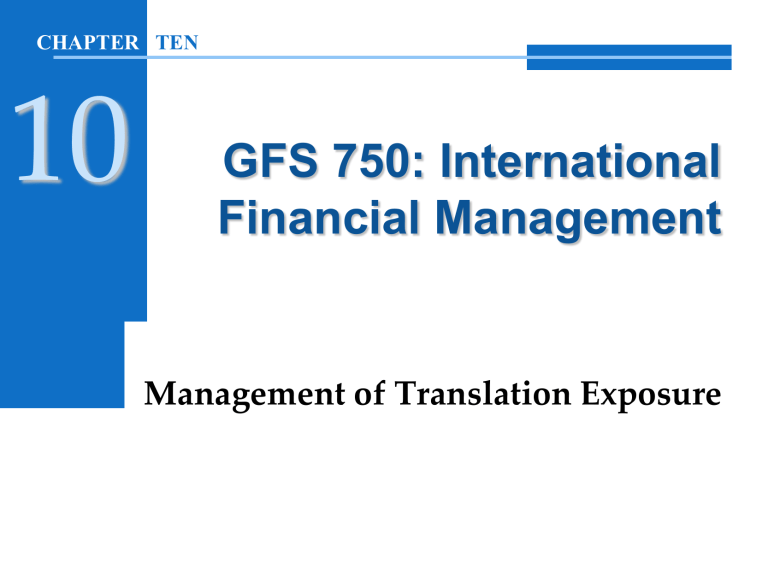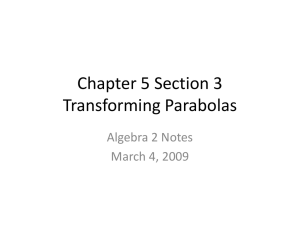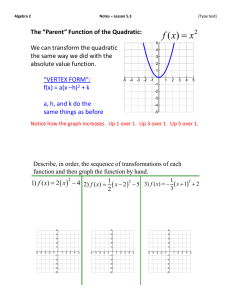
CHAPTER TEN 10 GFS 750: International Financial Management Management of Translation Exposure Outline Translation Methods Current/Noncurrent Method Monetary/Nonmonetary Method Temporal Method Current Rate Method Financial Accounting Standards Board Statement 8 Financial Accounting Standards Board Statement 52 The Mechanics of the FASB 52 Outline Translation Process Highly Inflationary Economies Management of Translation Exposure Translation Exposure versus Transaction Exposure Hedging Translation Exposure Balance Sheet Hedge Derivatives Hedge Translation Exposure versus Operating Exposure Introduction Translation exposure, also frequently called accounting exposure, refers to the effect that an unanticipated change in exchange rates will have on the consolidated financial reports of a MNC. Translation Methods 1. Current/Noncurrent Method: assets and liabilities should be translated based on their maturity. Current assets and liabilities are converted at the current exchange rate. Noncurrent assets and liabilities are translated at the historical exchange rate in effect at the time the asset or liability was first recorded on the books Income statement items are translated at the average exchange rate for the accounting period. Translation Methods 2. Monetary/ Nonmonetary Method: all monetary balance sheet accounts (cash, marketable securities, accounts receivable, notes payable, accounts payable) are translated at the current exchange rate. All other (nonmonetary) balance sheet accounts, including stockholders’ equity, are translated at the historical exchange rate in effect when the account was first recorded. Income statement accounts are translated at the average exchange rate for the period Translation Methods 3. Temporal Method: monetary accounts such as cash, receivables, and payables (both current and noncurrent) are translated at the current exchange rate. Other balance sheet accounts are translated at current rate, if they are carried on the books at current value; if they are carried at historical costs, they are translated at the rate of exchange on the date the item was placed on the books. Most income statement items are translated at the average exchange rate for the period. Translation Methods 4. Current Rate Method: all balance sheet accounts are translated at the current exchange rate, except for stockholders’ equity. The common stock account and any additional paid-in capital are carried at the exchange rates in effect on the respective dates of issuance. Income statement items are to be translated at the exchange rate at the dates the items are recognized. Effect of Translation Methods on Financial Statement Financial Accounting Standards Board Statement 8 Became effective on January 1, 1976. FASB 8 is essentially the temporal method of translation as previously defined, but there are some subtleties. FASB 8 ran into acceptance problems from the accounting profession and MNCs from the very beginning. Financial Accounting Standards Board Statement 52 FASB 52 was issued in December 1981 1. Dissatisfaction with FASB No. 8 - true profitability often disguised by exchange rate volatility – temporal method 2. Balance sheet translation uses current rate method. 3. Income statement uses: i. ii. Weighted average rate during period or The rate in effect when and expenses incurred. 11 Financial Accounting Standards Board Statement 52 4. Translation Gains or Losses i. Recorded in separate equity account on balance sheet. Known as cumulative translation adjustment account. 5. New Distinction under FASB No. 52: Functional vs. Reporting currency ii. i. Functional currency: for foreign subsidiary = the currency used in the primary economic environment in which it operates. Financial Accounting Standards Board Statement 52 ii. Reporting currency: the currency the parent firm uses to prepare its financial statements. The Mechanics of the FASB 52 Translation Process The actual translation process prescribed by FASB 52 is a two-stage process. i. Determine in which currency the foreign entity keeps its books - If the local currency in which the foreign entity keeps its books is not the functional currency, remeasurement into the functional currency is required. – use temporal method ii. When the foreign entity’s functional currency is not the same as the parent’s currency, the foreign entity’s books are translated from the functional currency into the reporting currency using the current rate method. The Mechanics of the FASB 52 Translation Process Highly Inflationary Economies A highly inflationary economy is defined as “one that has cumulative inflation of approximately 100 percent or more over a 3year period.” FASB 52 requires that the foreign entity’s financial statements be remeasured from the local currency “as if the functional currency were the reporting currency” using the temporal translation method. International Accounting Standards Since January 2005, all companies doing business in the European Union started using the accounting standards promulgated by the International Accounting Standards Board (IASB). Similar to the FASB, the ISAB publishes its standards in a series of pronouncements called International Financial Reporting Standards. Hedging Translation Exposure 1. Balance Sheet Hedge: translation exposure is not entity specific; rather, it is currency specific. Its source is a mismatch of net assets and net liabilities denominated in the same currency. A balance sheet hedge eliminates the mismatch. 2. Derivatives Hedge: a derivative product can be used to attempt to hedge potential loss. using a derivatives hedge to control translation exposure involves speculation about foreign exchange rate changes. 18 END Thank you! 1 - 19




